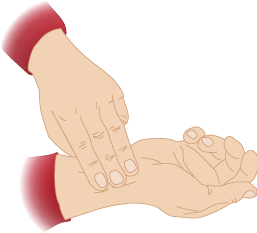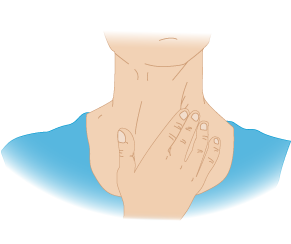-
Using a spreadsheet is helpful when finding the target heart rate zone for different ages.
The Cleveland Clinic gives the following steps to find your heart rate.
- Place the tips of your index, second, and third fingers on the palm side of your other wrist, below the base of the thumb. Or, place the tips of your index and second fingers on your lower neck, on either side of your windpipe. (See illustrations.)
- Press lightly with your fingers until you feel the blood pulsing beneath your fingers. You might need to move your fingers around slightly up or down until you feel the pulsing.
- Use a watch with a second hand, or look at a clock with a second hand.
- Count the beats you feel for 10 seconds. Multiply this number by six to get your heart rate per minute.



-
Busy schedules can make it difficult to find time for physical activity. We know exercise is good for us, but how can we fit in more of it? The Mayo Clinic lists some flexible and easy ways to add more activity to your busy days.
-
Instead of comparing fat calories burned per minute at the two rates, compare fat calories burned per minute as a percent of total calories burned per minute.

In the 60-65% zone, 50% of the total calories burned per minute are fat calories. In the 80-85% zone, only about 39% of the total calories burned per minute are fat calories. Because a greater percent of the total calories burned per minute are fat calories in the 60-65% zone than in the 80-85% zone, the 60-65% zone is called the "fat burning zone."
-
These comments are not screened before publication. Constructive debate about the information on this page is welcome, but personal attacks are not. Please do not post comments that are commercial in nature or that violate copyright. Comments that we regard as obscene, defamatory, or intended to incite violence will be removed. If you find a comment offensive, you may flag it.
When posting a comment, you agree to our Terms of Use.






Find out more on the andYOU blog: http://www.andyou.com/blog/health-fitness/math-in-the-news-heart-rate/
Thank you for the comment. I love the wood burning analogy. It certainly helps make the difference between the fat burning zone and the cardio zone simple to understand.
But when exertion is increased to 80-85% MHR and higher, the body relies more on glucose / carbohydrate stores. This is a quick burning and limited source of fuel. A good analogy of this is placing easy-burning kindling wood in the fireplace; it quickly burns and provides heat but only for a limited time as it also then quickly burns to ashes.
As one performs more regular activity, the body becomes more efficient in its mixing of these two fuel sources, and accomplishes activity faster with more endurance, everything else (advancing age, nutrition, sleep/rest, equipment, stress, etc) being equal. Top endurance runners learn this and are careful to not go too far too often into their red zone of 80+% MHR; one obviously cannot hold a 100meter sprint pace for very long.
http://lifehacker.com/331319/fifteen-foods-that-burn-more-calories-than-they-contain